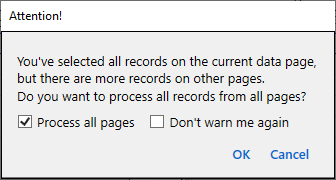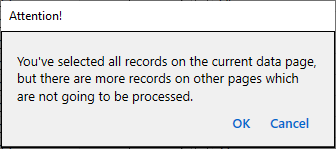This dialog can be displayed to request parameters for the upcoming data merge/delete script generation. The dialog is triggered by the Merge or Delete actions in the Data diff tab.

The Free version excludes some options and just warns about potential limitations instead:

Once the confirmation is OK, the next step is typically script generation and the Execute script dialog (see below for exclusions related to Id-Remap and 'Update changed only' scenarios).
The dialog contains the following sections.
You're going to {merge or delete} one or more rows
Target database:
{Database display name}
Click OK to proceed with script generation using the settings below. This action can be canceled on the next step.
This table has identity/sequence primary key and the database contains other tables referencing these primary key values by foreign keys.If Id-Remap Merge can be applied, this text is followed by the option to enable it:
☐ Use Id-Remap MergeIn this case, the next step in our merge execution flow will be the Id-Remap Merge dialog to set up additional configuration for Id-Remap Merge.
Id-Remap Merge can not be used because this table has no dependency level. Click OK to proceed merge with the regular data merge.You can find more information about table dependency levels on the appropriate help page, and more information about why it is necessary for Id-Remap in the Id-Remap Merge dialog help page.
If disabled, DB engine will generate new values which most likely will be different
☐ Import existing identity, sequence or other auto-generated values on INSERT
You've selected all rows on the current data page, but there are more rows on other pages.The Free version simply warns that only the current page will be processed:
Do you want to process all rows from all pages?
☐ Process all pages
You've selected all rows on the current data page, but there are more rows on other pages which are not going to be processed.
If the generated script will contain UPDATE statements, it can include all or only changed column values. In the last case, script will not be generated for unchanged rows.As mentioned above, this option excludes unchanged rows from the generated script. If it turns out that all selected rows are unchanged, then the merge action concludes with a No changes to merge message.
Wrap table data operations in a transaction. Can also provide better performance.If enabled, the generated script is wrapped with BEGIN TRANSACTION and COMMIT statements.
☐ With transaction
This section is shown if the target table has related active (non-disabled) triggers. In case of the regular (non-Id-Remap) action, for the Merge it is triggers on INSERT or UPDATE, and for Delete it is triggers on DELETE. In this case this option has the following description:
The target table has active triggers which may modify data in other tables (application does not analyze trigger logic). To ensure that only the target table is affected, you can temporarily disable these triggers.
In case of Id-Remap Merge, this section can be available even if target table has no related triggers, but there are some other database tables with related triggers. That's because Id-Remap affects not only target table but can affect some other dependant tables and we don't know in advance theh list of these tables - this is configured in the next Id-Remap merge configuration. Related triggers are only INSERT triggers in this case, because Id-Remap always created new rows. Option description in this case is the following:
The target database has tables with active INSERT triggers which may modify data in other tables. Application does not analyze trigger logic and the list of affected tables is unknown before Id-Remap merge confirmation. To ensure that only the target tables is affected, you can temporarily disable triggers for all affected tables, if any.
The option itself and additional comment regarding its behaviour:
☐ Temporarily disable relevant triggers
If enabled and executed without transaction, then 'Stop on first error' option is not available in further 'Execute script' dialog (stopped execution could leave trigger disabled).
If the option is enabled, the generated script contains statements to disable triggers in the beginning of the operation and to enable them back in the end.
The default state of Auto-generated primary key values, Merge all pages, Update only changed, and Transactions options is taken from previous confirmation.